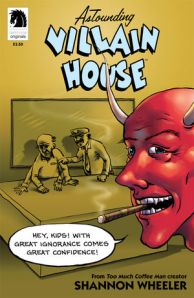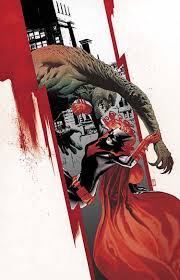Writer: Ales Kot
Artist: Mateus Santolouco
Image Comics
Much of the media coverage surrounding Ales Kot’s innovative new series has focused on the format of the book itself. If you haven’t been filled in, the deal is that he writes a single self-contained story each month for a different artist. Each issue builds on the established world and its characters, without following any prescribed point A to point B linear narrative. It’s a compelling strategy that is uniquely suited to maintain the relevance of the monthly issue in a climate that demands collectible ongoing stories. Kot’s narrative technique no-doubt has reader’s who favor the formalist approach to graphic storytelling sqeeing in collective glee, however, after three issues of the book I’m convinced that it is his focused and precise storytelling that makes his structural approach work, and not the other way around.
Background is the bane of the monthly comic writer. Not enough, and new readers are lost, too much and long time readers become frustrated and bored. Info dumps in the form of prose at the start of an issue are at best redundant and at worst jarring. In-narrative exposition wastes valuable real estate and can put a reader to sleep. Quick character profiles are sometimes the best way to go, they can at least cue the reader in on who’s good, who’s bad, who’s important, and who to watch. It depends, of course, on how character driven the narrative is. This works especially well with Zero as the narrative boils down entirely to what we know about the characters, which is to say not much.
On the first page we get the following three bios:
Zero: Edward Zero is a secret agent. He works for the agency. This is the story of his life
Mina Thorpe: Zero’s friend. Also works for the Agency
Ginsberg Nova: Bin Laden is dead. Ginsberg Nova is not.
Creating compelling fiction is all about setting up questions that drive the reader to keep reading. The questions set up in these quick profiles are: what is the agency? and what is the nature of these characters’ relationships to it. These questions are the same every issue. It almost seems too simple, but that’s the misdirection at play. The answers to these simple questions are inconceivably complex. Rather than building in a linear manner, leading the reader from one reveal to the next, each issue reveals a different aspect of the agency, and a different layer of Zero’s relationship to it. The issues move backward and forward in time, bringing different actors and themes to the foreground as the mosaic that is the secret organization and Zero’s life as one of its members slowly resolves itself.
Quietly, it seems the comic industry has been trying a handful of tactics to incentivize monthly purchases. Marvel and DC stick with the relatively mundane read-it-here-first premium, often waiting months before collecting a completed storyline. Other Image titles have used the letters column as a means of building a relationship with the fans and presenting exclusive material (Brian k. Vaughan and Matt Fraction are doing this particularly well with Saga and Sex Criminals respectively). But this is the first time, and least in a while, where the storytelling itself caters to the monthly readership, and more importantly, the first time readers. I can’t think of a single reason why a new reader would be any less capable of picking up issue #3 than someone who has also read the first two. That’s not to say that reading every issue doesn’t enrich the experience, it just doesn’t matter in what order you read them. Of course, with Mateus Santolouco’s hyper-kinetic and stylish art on display in this issue, I can’t think of any reason to wait another month before giving Zero a shot.




 Posted by tvgilbert
Posted by tvgilbert 








